Evaluation and Global-Scale Observation of Nitrous Oxide from IASI on Metop-A
Abstract
:1. Introduction
2. Data and Method
2.1. The IASI Space-Borne Instrument
2.2. The HIPPO Campaigns
2.3. The NOAA Airborne Campaigns
2.4. The NDAAC NO Ground-Based Observations
2.5. The EUMETSAT Products
2.6. Methodology
3. The TNOR v2.0 Scientific Tool
3.1. The RTTOV Radiative Transfer Model
3.2. The Levenberg-Marquardt Optimal Estimation Method
3.3. Specifics of TNOR v2.0
3.4. Sensitivity Profile and Error Characterization
4. Results
4.1. Evaluation of IASI TNOR v2.0 NO Retrievals
4.1.1. Comparison with Aircraft Observations
4.1.2. NDAAC Ground-Based Observations
4.2. Global-Scale Distribution of IASI NO
5. Conclusions
Supplementary Materials
Author Contributions
Funding
Data Availability Statement
Acknowledgments
Conflicts of Interest
References
- Prather, M.J.; Hsu, J.; DeLuca, N.M.; Jackman, C.H.; Oman, L.D.; Douglass, A.R.; Fleming, E.L.; Strahan, S.E.; Steenrod, S.D.; Søvde, O.A.; et al. Measuring and modeling the lifetime of nitrous oxide including its variability. J. Geophys. Res. Atmos. 2015, 120, 5693–5705. [Google Scholar] [CrossRef] [PubMed]
- Stocker, T. Climate Change 2013: The Physical Science Basis: Working Group I Contribution to the Fifth Assessment Report of the Intergovernmental Panel on Climate Change; Cambridge University Press: Cambridge, UK, 2014. [Google Scholar]
- Ravishankara, A.; Daniel, J.S.; Portmann, R.W. Nitrous oxide (N2O): The dominant ozone-depleting substance emitted in the 21st century. Science 2009, 326, 123–125. [Google Scholar] [CrossRef] [PubMed] [Green Version]
- Tian, H.; Xu, R.; Canadell, J.G.; Thompson, R.L.; Winiwarter, W.; Suntharalingam, P.; Davidson, E.A.; Ciais, P.; Jackson, R.B.; Janssens-Maenhout, G.; et al. A comprehensive quantification of global nitrous oxide sources and sinks. Nature 2020, 586, 248–256. [Google Scholar] [CrossRef] [PubMed]
- Bakker, D.C.; Bange, H.W.; Gruber, N.; Johannessen, T.; Upstill-Goddard, R.C.; Borges, A.V.; Delille, B.; Löscher, C.R.; Naqvi, S.; Omar, A.M.; et al. Air-sea interactions of natural long-lived greenhouse gases (CO2, N2O, CH4) in a changing climate. In Ocean-Atmosphere Interactions of Gases and Particles; Springer: Berlin/Heidelberg, Germany, 2014. [Google Scholar]
- Minschwaner, K.; Salawitch, R.; McElroy, M. Absorption of solar radiation by O2: Implications for O3 and lifetimes of N2O, CFCl3, and CF2Cl2. J. Geophys. Res. Atmos. 1993, 98, 10543–10561. [Google Scholar] [CrossRef]
- Xiong, X.; Maddy, E.S.; Barnet, C.; Gambacorta, A.; Patra, P.K.; Sun, F.; Goldberg, M. Retrieval of nitrous oxide from Atmospheric Infrared Sounder: Characterization and validation. J. Geophys. Res. Atmos. 2014, 119, 9107–9122. [Google Scholar] [CrossRef]
- Kangah, Y.; Ricaud, P.; Attié, J.L.; Saitoh, N.; Hauglustaine, D.A.; Wang, R.; El Amraoui, L.; Zbinden, R.; Delon, C. Summertime upper tropospheric nitrous oxide over the Mediterranean as a footprint of Asian emissions. J. Geophys. Res. Atmos. 2017, 122, 4746–4759. [Google Scholar] [CrossRef]
- García, O.E.; Schneider, M.; Ertl, B.; Sepúlveda, E.; Borger, C.; Diekmann, C.; Wiegele, A.; Hase, F.; Barthlott, S.; Blumenstock, T.; et al. The MUSICA IASI CH4 and N2O products and their comparison to HIPPO, GAW and NDACC FTIR references. Atmos. Meas. Tech. 2018, 11, 4171–4215. [Google Scholar] [CrossRef] [Green Version]
- Ricaud, P.; Attié, J.L.; Teyssèdre, H.; Amraoui, L.E.; Peuch, V.H.; Matricardi, M.; Schluessel, P. Equatorial total column of nitrous oxide as measured by IASI on MetOp-A: Implications for transport processes. Atmos. Chem. Phys. 2009, 9, 3947–3956. [Google Scholar] [CrossRef] [Green Version]
- Ricaud, P.; Sič, B.; El Amraoui, L.; Attié, J.L.; Zbinden, R.; Huszar, P.; Szopa, S.; Parmentier, J.; Jaidan, N.; Michou, M.; et al. Impact of the Asian monsoon anticyclone on the variability of mid-to-upper tropospheric methane above the Mediterranean Basin. Atmos. Chem. Phys. 2014, 14, 11427–11446. [Google Scholar] [CrossRef] [Green Version]
- García, O.E.; Sepúlveda, E.; Schneider, M.; Hase, F.; August, T.; Blumenstock, T.; Kühl, S.; Munro, R.; Gómez-Peláez, Á.J.; Hultberg, T.; et al. Consistency and quality assessment of the Metop-A/IASI and Metop-B/IASI operational trace gas products (O3, CO, N2O, CH4, and CO2) in the subtropical North Atlantic. Atmos. Meas. Tech. 2016, 9, 2315–2333. [Google Scholar] [CrossRef] [Green Version]
- Turquety, S.; Hadji-Lazaro, J.; Clerbaux, C.; Hauglustaine, D.; Clough, S.; Cassé, V.; Schlüssel, P.; Mégie, G. Operational trace gas retrieval algorithm for the Infrared Atmospheric Sounding Interferometer. J. Geophys. Res. Atmos. 2004, 109. [Google Scholar] [CrossRef]
- Kangah, K.G.Y. Mesure du Protoxyde D’azote (N2O) Depuis l’espace. Ph.D. Thesis, Université Paul Sabatier-Toulouse III, Toulouse, France, 2017. [Google Scholar]
- Barret, B.; Gouzenes, Y.; Le Flochmoen, E.; Ferrant, S. Retrieval of Metop-A/IASI N2O profiles and validation with NDACC FTIR data. Atmosphere 2021, 12, 219. [Google Scholar] [CrossRef]
- Hilton, F.; Armante, R.; August, T.; Barnet, C.; Bouchard, A.; Camy-Peyret, C.; Capelle, V.; Clarisse, L.; Clerbaux, C.; Coheur, P.F.; et al. Hyperspectral Earth observation from IASI: Five years of accomplishments. Bull. Am. Meteorol. Soc. 2012, 93, 347–370. [Google Scholar] [CrossRef]
- Pougatchev, N.; August, T.; Calbet, X.; Hultberg, T.; Oduleye, O.; Schlüssel, P.; Stiller, B.; Germain, K.S.; Bingham, G. IASI temperature and water vapor retrievals—Error assessment and validation. Atmos. Chem. Phys. 2009, 9, 6453–6458. [Google Scholar] [CrossRef] [Green Version]
- Rodgers, C.D. Inverse Methods for Atmospheric Sounding: Theory and Practice; World Scientific: Singapore, 2000; Volume 2. [Google Scholar]
- Dufour, G.; Eremenko, M.; Griesfeller, A.; Barret, B.; LeFlochmoën, E.; Clerbaux, C.; Hadji-Lazaro, J.; Coheur, P.F.; Hurtmans, D. Validation of three different scientific ozone products retrieved from IASI spectra using ozonesondes. Atmos. Meas. Tech. 2012, 5, 611–630. [Google Scholar] [CrossRef] [Green Version]
- Wofsy, S.C. HIAPER Pole-to-Pole Observations (HIPPO): Fine-grained, global-scale measurements of climatically important atmospheric gases and aerosols. Philos. Trans. R. Soc. A 2011, 369, 2073–2086. [Google Scholar] [CrossRef]
- Wofsy, S.C.; Daube, B.C.; Jimenez, R.; Kort, E.; Pittman, J.V.; Park, S.; Commane, R.; Xiang, B.; Santoni, G.; Jacob, D.; et al. HIPPO Merged 10-Second Meteorology and Atmospheric Chemistry and Aerosol Data (R_20121129). Philos. Trans. R. Soc. A 2012. [Google Scholar] [CrossRef]
- Hauglustaine, D.; Hourdin, F.; Jourdain, L.; Filiberti, M.A.; Walters, S.; Lamarque, J.F.; Holland, E. Interactive chemistry in the Laboratoire de Météorologie Dynamique general circulation model: Description and background tropospheric chemistry evaluation. J. Geophys. Res. Atmos. 2004, 109. [Google Scholar] [CrossRef]
- Kort, E.; Patra, P.; Ishijima, K.; Daube, B.; Jimenez, R.; Elkins, J.; Hurst, D.; Moore, F.; Sweeney, C.; Wofsy, S. Tropospheric distribution and variability of N2O: Evidence for strong tropical emissions. Geophys. Res. Lett. 2011, 38. [Google Scholar] [CrossRef] [Green Version]
- Sweeney, C.; Karion, A.; Wolter, S.; Newberger, T.; Guenther, D.; Higgs, J.A.; Andrews, A.E.; Lang, P.M.; Neff, D.; Dlugokencky, E.; et al. Seasonal climatology of CO2 across North America from aircraft measurements in the NOAA/ESRL Global Greenhouse Gas Reference Network. J. Geophys. Res. Atmos. 2015, 120, 5155–5190. [Google Scholar] [CrossRef]
- Sepúlveda, E.; Schneider, M.; Hase, F.; Barthlott, S.; Dubravica, D.; García, O.E.; Gomez-Pelaez, A.; González, Y.; Guerra, J.C.; Gisi, M.; et al. Tropospheric CH4 signals as observed by NDACC FTIR at globally distributed sites and comparison to GAW surface in situ measurements. Atmos. Meas. Tech. 2014, 7, 2337–2360. [Google Scholar] [CrossRef] [Green Version]
- Saunders, R.; Matricardi, M.; Brunel, P. An improved fast radiative transfer model for assimilation of satellite radiance observations. Q. J. R. Meteorol. Soc. 1999, 125, 1407–1425. [Google Scholar] [CrossRef]
- Saunders, R.; Hocking, J.; Turner, E.; Rayer, P.; Rundle, D.; Brunel, P.; Vidot, J.; Roquet, P.; Matricardi, M.; Geer, A.; et al. An update on the RTTOV fast radiative transfer model (currently at version 12). Geosci. Model Dev. 2018, 11, 2717–2737. [Google Scholar] [CrossRef] [Green Version]
- Hocking, J.; Rayer, P.; Rundle, D.; Saunders, R.; Matricardi, M.; Geer, A.; Brunel, P.; Vidot, J. RTTOV v11 Users Guide; Met-Office, ECMWF, Météo-France: Paris, France, 2015. [Google Scholar]
- Matricardi, M. An assessment of the accuracy of the RTTOV fast radiative transfer model using IASI data. Atmos. Chem. Phys. 2009, 9, 6899–6913. [Google Scholar] [CrossRef] [Green Version]
- Matricardi, M. The Generation of RTTOV Regression Coefficients for IASI and AIRS Using a New Profile Training Set and a New Line-by-Line Database; ECMWF Reading: Reading, UK, 2008. [Google Scholar]
- Saunders, R.; Hocking, J.; Rundle, D.; Rayer, P.; Havemann, S.; Matricardi, M.; Geer, A.; Lupu, C.; Brunel, P.; Vidot, J. RTTOV-12: Science and Validation Report; Met-Office, ECMWF, Météo-France: Paris, France, 2017. [Google Scholar]
- Chevallier, F.; Di Michele, S.; McNally, A.P. Diverse Profile Datasets from the ECMWF 91-Level Short-Range Forecasts; European Centre for Medium-Range Weather Forecasts: Reading, UK, 2006. [Google Scholar]
- Ricaud, P.; Attié, J.L.; Chalinel, R.; Pasternak, F.; Léonard, J.; Pison, I.; Pattey, E.; Thompson, R.L.; Zelinger, Z.; Lelieveld, J.; et al. The Monitoring Nitrous Oxide Sources (MIN2OS) satellite project. Remote Sens. Environ. 2021, 266, 112688. [Google Scholar] [CrossRef]
- Levenberg, K. A method for the solution of certain non-linear problems in least squares. Q. Appl. Math. 1944, 2, 164–168. [Google Scholar] [CrossRef] [Green Version]
- Marquardt, D.W. An algorithm for least-squares estimation of nonlinear parameters. J. Soc. Ind. Appl. Math. 1963, 11, 431–441. [Google Scholar] [CrossRef]
- Massart, S.; Agusti-Panareda, A.; Aben, I.; Butz, A.; Chevallier, F.; Crevoisier, C.; Engelen, R.; Frankenberg, C.; Hasekamp, O. Assimilation of atmospheric methane products into the MACC-II system: from SCIAMACHY to TANSO and IASI. Atmos. Chem. Phys. 2014, 14, 6139–6158. [Google Scholar] [CrossRef] [Green Version]
- Loveless, M.; Borbas, E.E.; Knuteson, R.; Cawse-Nicholson, K.; Hulley, G.; Hook, S. Climatology of the Combined ASTER MODIS Emissivity over Land (CAMEL) Version 2. Remote Sens. 2021, 13, 111. [Google Scholar] [CrossRef]
- Konda, M.; Imasato, N.; Nishi, K.; Toda, T. Measurement of the sea surface emissivity. J. Oceanogr. 1994, 50, 17–30. [Google Scholar] [CrossRef]
- Clarisse, L.; Coheur, P.F.; Prata, F.; Hadji-Lazaro, J.; Hurtmans, D.; Clerbaux, C. A unified approach to infrared aerosol remote sensing and type specification. Atmos. Chem. Phys. 2013, 13, 2195–2221. [Google Scholar] [CrossRef] [Green Version]
- Cuesta, J.; Eremenko, M.; Flamant, C.; Dufour, G.; Laurent, B.; Bergametti, G.; Höpfner, M.; Orphal, J.; Zhou, D. Three-dimensional distribution of a major desert dust outbreak over East Asia in March 2008 derived from IASI satellite observations. J. Geophys. Res. Atmos. 2015, 120, 7099–7127. [Google Scholar] [CrossRef] [Green Version]
- Rodgers, C.D.; Connor, B.J. Intercomparison of remote sounding instruments. J. Geophys. Res. Atmos. 2003, 108. [Google Scholar] [CrossRef] [Green Version]
- Ricaud, P.; Zbinden, R.; Catoire, V.; Brocchi, V.; Dulac, F.; Hamonou, E.; Canonici, J.C.; El Amraoui, L.; Massart, S.; Piguet, B.; et al. The GLAM Airborne Campaign across the Mediterranean Basin. Bull. Am. Meteorol. Soc. 2018, 99, 361–380. [Google Scholar] [CrossRef] [Green Version]
- Liu, C.; Zipser, E.J. Global distribution of convection penetrating the tropical tropopause. J. Geophys. Res. Atmos. 2005, 110. [Google Scholar] [CrossRef] [Green Version]
- Dion, I.A.; Ricaud, P.; Haynes, P.; Carminati, F.; Dauhut, T. Ice injected into the tropopause by deep convection—Part 1: In the austral convective tropics. Atmos. Chem. Phys. 2019, 19, 6459–6479. [Google Scholar] [CrossRef] [Green Version]
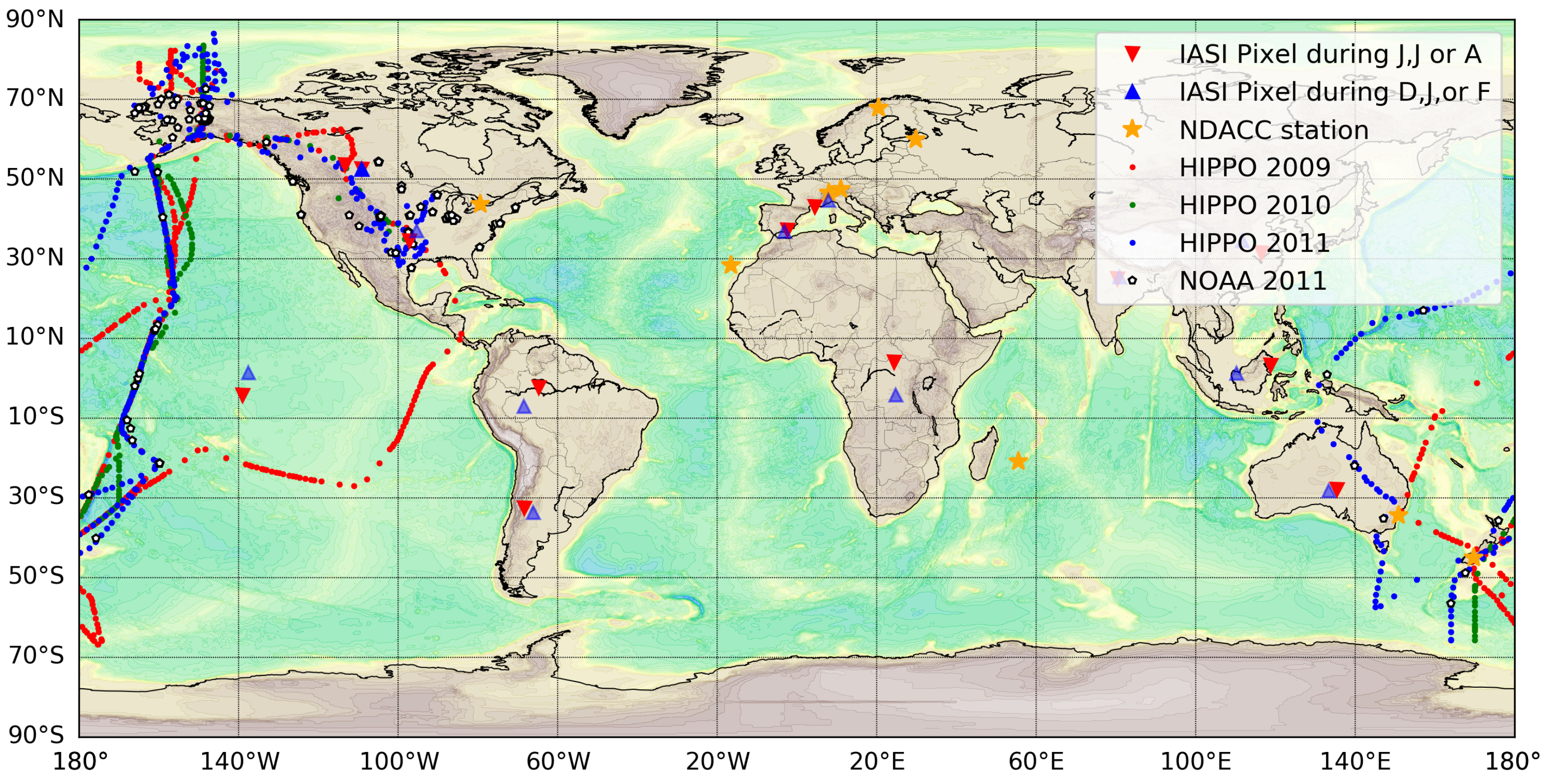
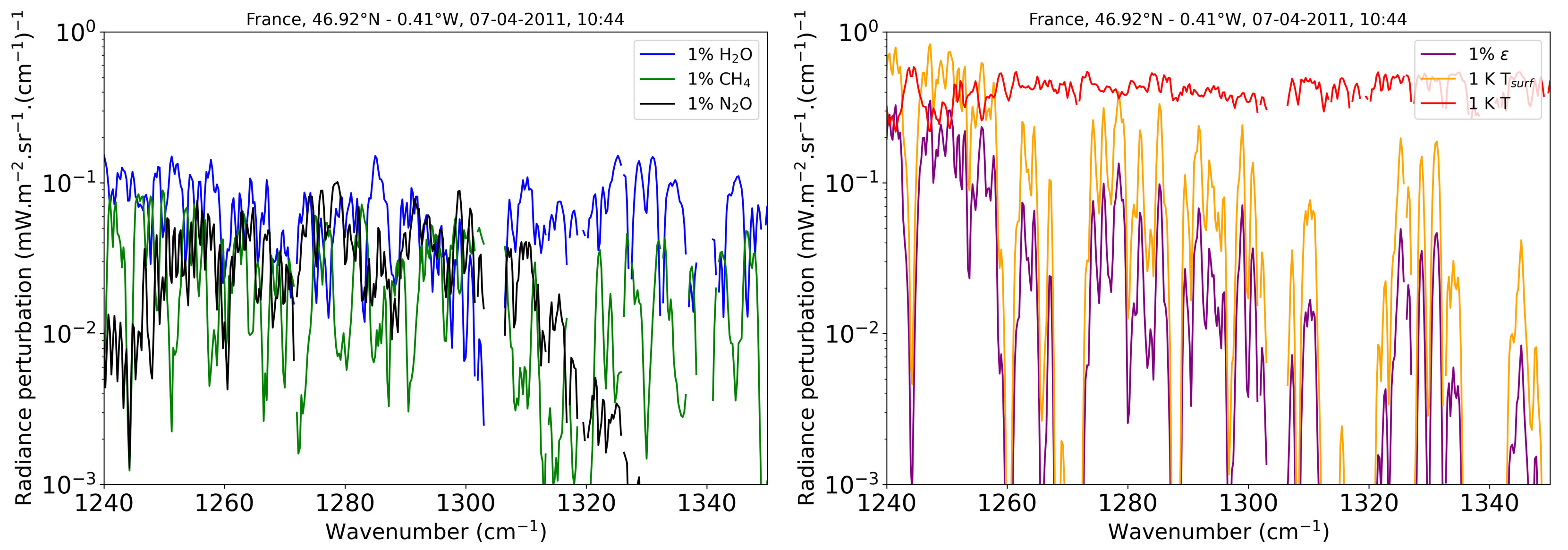
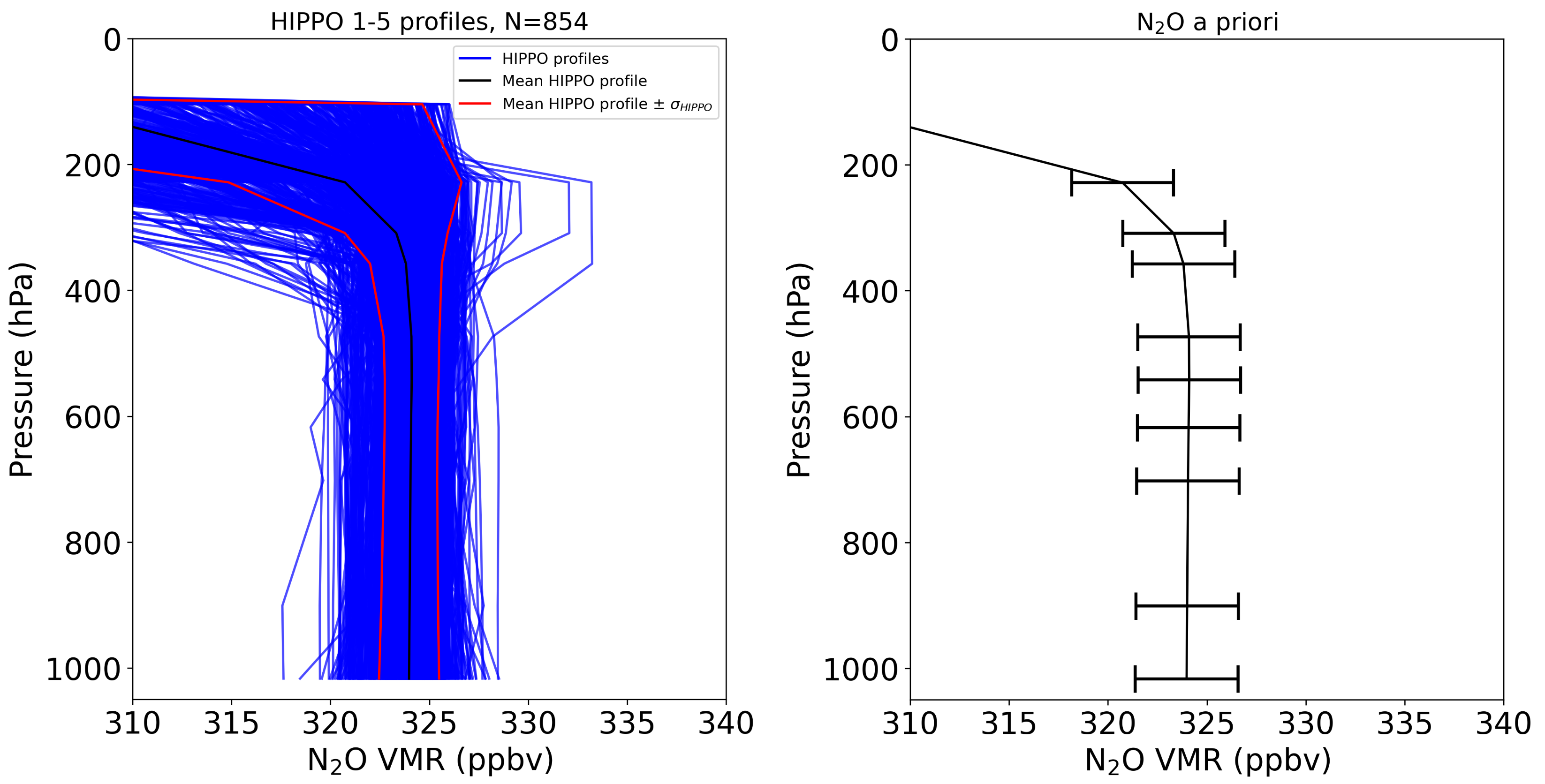

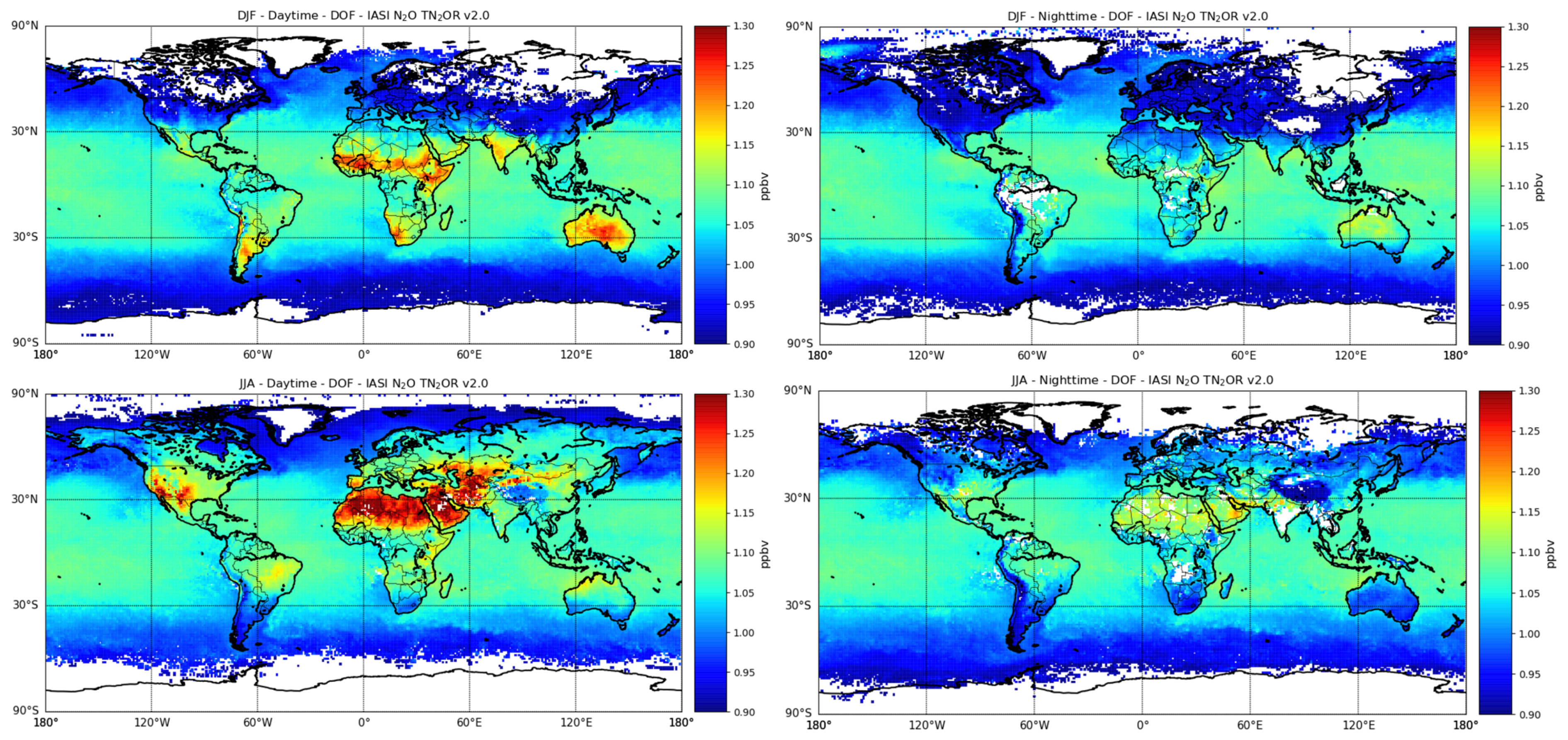



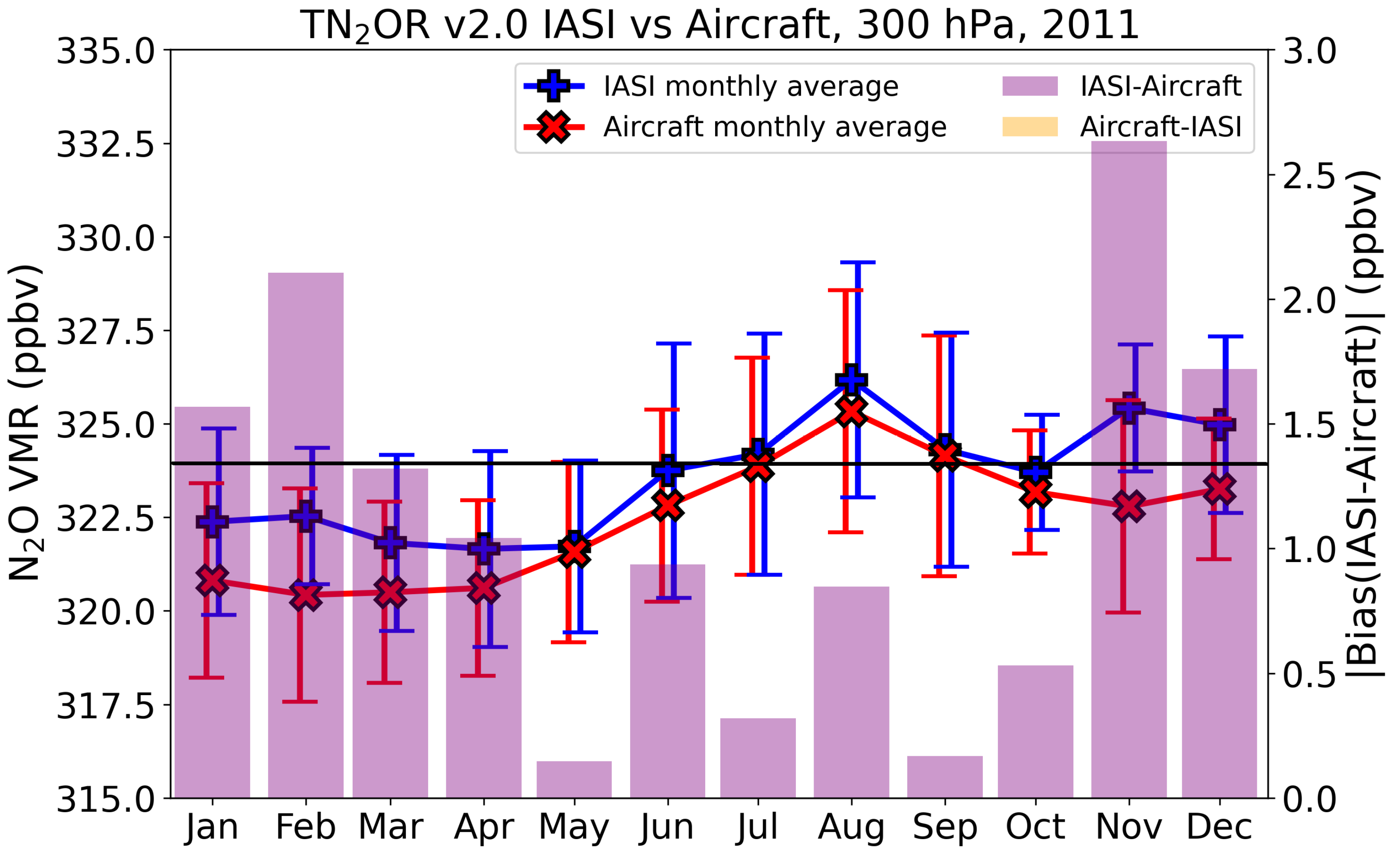

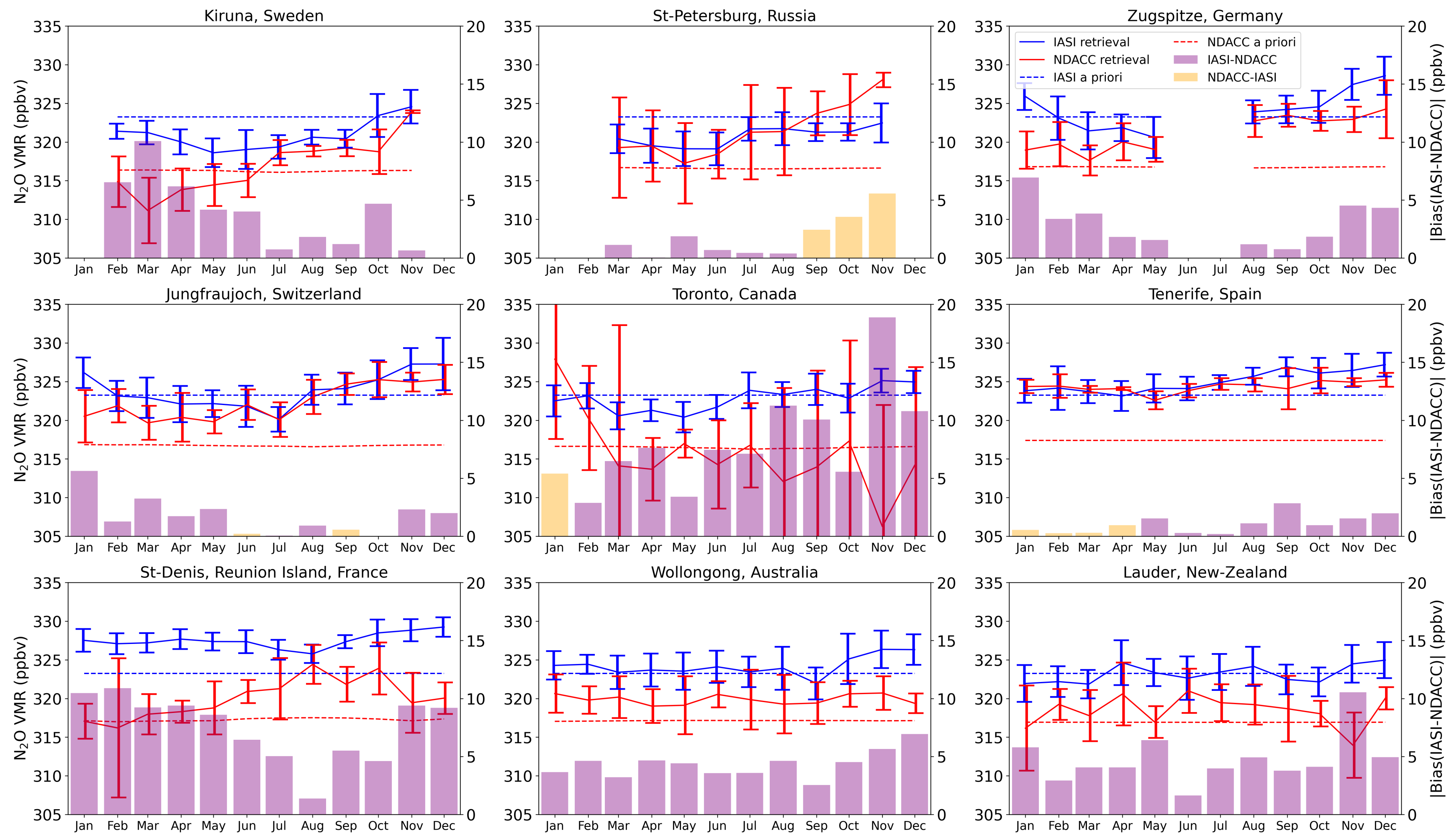
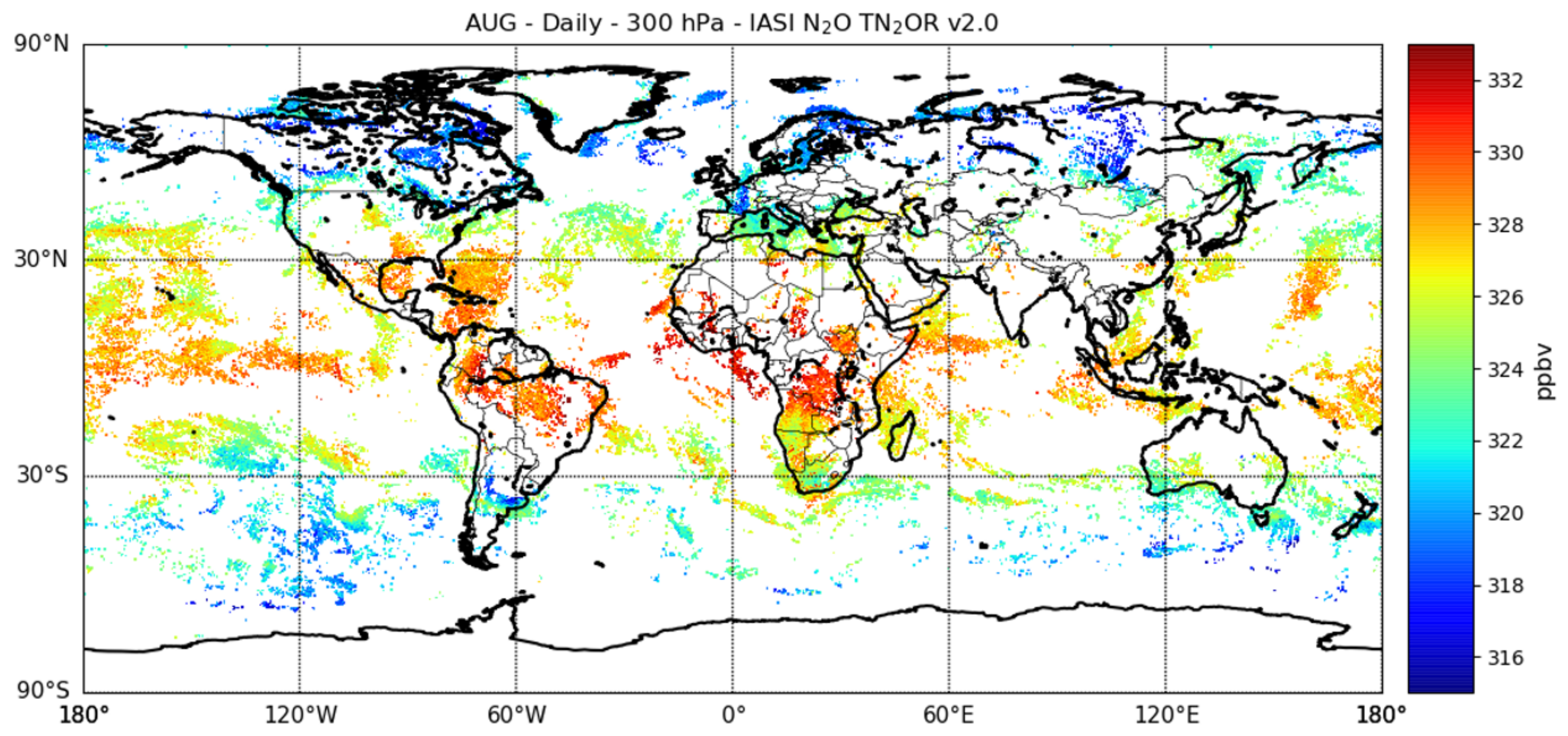

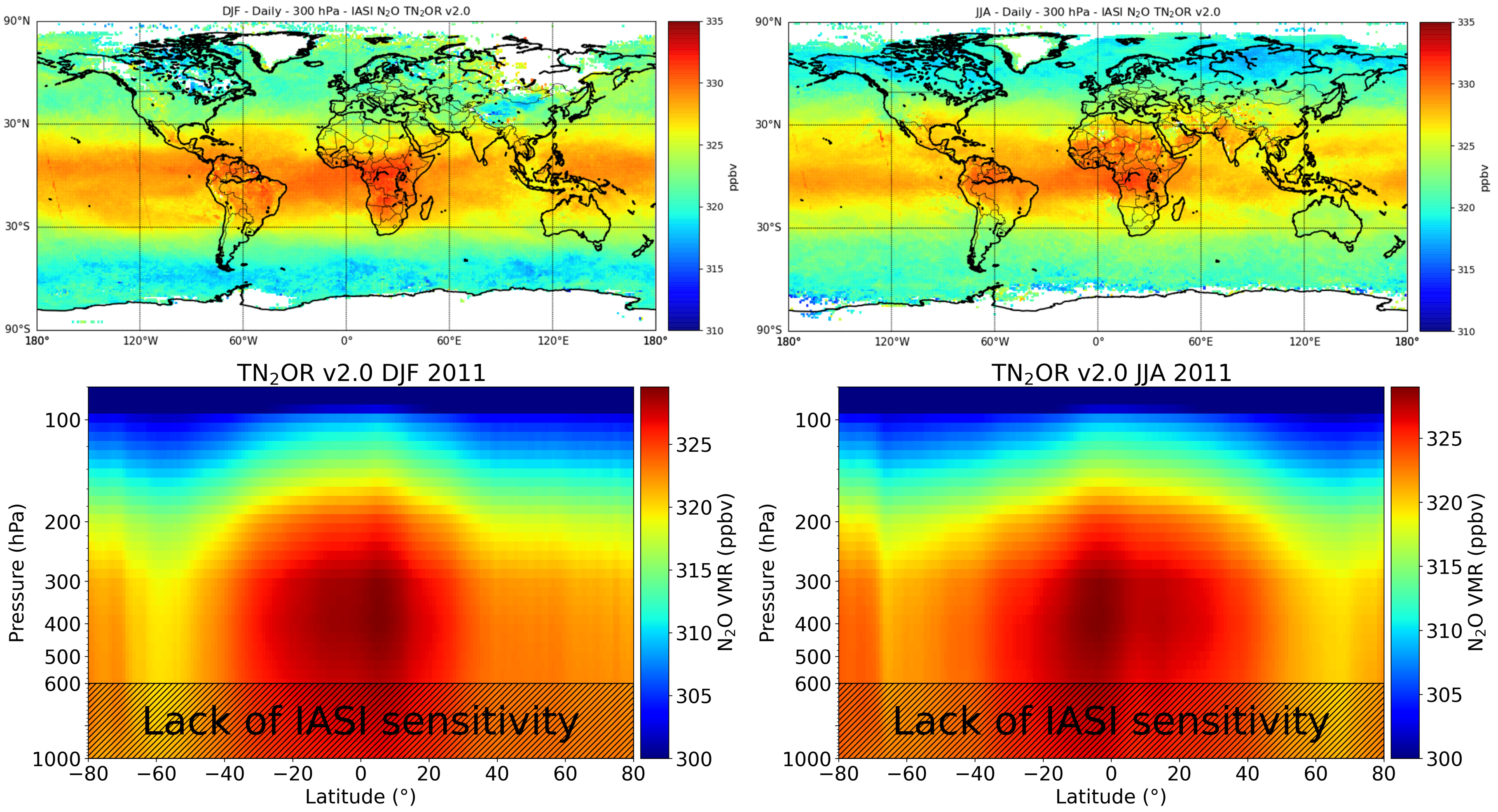
| Pixel # | Location | Latitude | Longitude | Date /2011 | Time /UT | Surface P. /hPa |
|---|---|---|---|---|---|---|
| 1 | Canada | 52.55°N | 109.13°W | 11 June | 17:04 | 934.7 |
| 2 | 53.48°N | 113.35°W | 24 December | 04:50 | 936.54 | |
| 3 | France | 46.92°N | 0.41°W | 4 July | 10:44 | 998.73 |
| 4 | 49.51°N | 1.89°E | 8 February | 11:04 | 1008.69 | |
| 5 | Spain | 36.94°N | 3.11°W | 25 August | 09:30 | 979.8 |
| 6 | 37.14°N | 2.41°W | 23 February | 09:17 | 939.8 | |
| 7 | USA | 37.09°N | 95.41°W | 15 June | 15:44 | 977.8 |
| 8 | 34.41°N | 97.23°W | 15 February | 17:08 | 984.37 | |
| 9 | China | 34.55°N | 111.68°E | 7 June | 01:39 | 944.15 |
| 10 | 31.46°N | 116.41°E | 2 December | 02:49 | 1005.02 | |
| 11 | India | 25.45°N | 80.92°E | 7 June | 05:04 | 977.2 |
| 12 | 24.99°N | 80.37°E | 26 February | 04:54 | 977.35 | |
| 13 | Congo Rainforest | 4.09°S | 24.77°E | 7 July | 08:14 | 943.86 |
| 14 | 4.11°N | 24.43°E | 16 February | 08:29 | 944.33 | |
| 15 | Indonesia | 1.28°N | 110.2°E | 24 August | 01:35 | 985.84 |
| 16 | 3.22°N | 118.82°E | 8 January | 12:53 | 1007.02 | |
| 17 | Pacific ocean | 1.45°N | 137.59°W | 12 June | 06:00 | 1010.93 |
| 18 | 4.28°S | 139.03°W | 5 December | 06:09 | 1012.0 | |
| 19 | Amazonia | 6.96°S | 68.43°W | 11 August | 14:36 | 1000.62 |
| 20 | 2.32°S | 64.77°W | 30 December | 13:29 | 1003.5 | |
| 21 | Australia | 28.2°S | 133.35°E | 31 August | 00:57 | 990.16 |
| 22 | 27.9°S | 135.42°E | 2 December | 23:24 | 992.41 | |
| 23 | Argentina | 33.62°S | 66.15°W | 22 August | 14:15 | 960.27 |
| 24 | 32.57°S | 68.4°W | 24 December | 14:01 | 948.56 |
| Parameters | NO | CH | HO | Temp | T | |
|---|---|---|---|---|---|---|
| A priori | From HIPPO and LMDz-INCA | MACC-II | IASI | IASI | IASI | CAMEL (land) 0.984 (sea) |
| x | 0.8% | 1% | 10% | 0.5 K | 1.5 K | 15% |
| Latitudes | N | (ppbv) | (ppbv) | R | Bias (ppbv) |
|---|---|---|---|---|---|
| 60°S–30°S | 45 | 2.36 | 2.69 | 0.76 | 1.48 |
| 30°S–0° | 60 | 1.82 | 1.92 | 0.61 | −0.03 |
| 0°–30°N | 64 | 2.13 | 1.42 | 0.56 | −0.39 |
| 30°N–60°N | 328 | 2.91 | 2.63 | 0.71 | 0.97 |
| 60°N–90°N | 95 | 1.93 | 2.19 | 0.13 | 2.56 |
| Station | Lat | Lon | H (m amsl) | R | Bias (ppbv) | (ppbv) | |
|---|---|---|---|---|---|---|---|
| IASI | NDACC | ||||||
| Kiruna | 67.84°N | 20.41°E | 419 | 0.56 | 4.0 | 1.8 | 3.48 |
| St Petersburg | 59.9°N | 29.8°E | 20 | 0.85 | −0.78 | 1.17 | 3.25 |
| Zugspitze | 47.42°N | 10.98°E | 2964 | 0.69 | 3.01 | 2.45 | 2.19 |
| Jungfraujoch | 46.55°N | 7.98°E | 3580 | 0.7 | 1.56 | 2.16 | 2.16 |
| Toronto | 43.66°N | 79.40°W | 174 | −0.28 | 7.18 | 1.51 | 4.93 |
| Tenerife | 28.30°N | 16.48°W | 2367 | 0.56 | 0.7 | 1.32 | 0.68 |
| St-Denis | 20.9°S | 55.5°E | 85 | −0.16 | 7.51 | 0.94 | 2.45 |
| Wollongong | 34.41°S | 150.88°E | 30 | 0.38 | 4.33 | 1.2 | 0.61 |
| Lauder | 45.04°S | 169.68°E | 370 | 0.1 | 4.76 | 1.09 | 1.92 |
Publisher’s Note: MDPI stays neutral with regard to jurisdictional claims in published maps and institutional affiliations. |
© 2022 by the authors. Licensee MDPI, Basel, Switzerland. This article is an open access article distributed under the terms and conditions of the Creative Commons Attribution (CC BY) license (https://creativecommons.org/licenses/by/4.0/).
Share and Cite
Chalinel, R.; Attié, J.-L.; Ricaud, P.; Vidot, J.; Kangah, Y.; Hauglustaine, D.; Thompson, R. Evaluation and Global-Scale Observation of Nitrous Oxide from IASI on Metop-A. Remote Sens. 2022, 14, 1403. https://doi.org/10.3390/rs14061403
Chalinel R, Attié J-L, Ricaud P, Vidot J, Kangah Y, Hauglustaine D, Thompson R. Evaluation and Global-Scale Observation of Nitrous Oxide from IASI on Metop-A. Remote Sensing. 2022; 14(6):1403. https://doi.org/10.3390/rs14061403
Chicago/Turabian StyleChalinel, Rémi, Jean-Luc Attié, Philippe Ricaud, Jérôme Vidot, Yannick Kangah, Didier Hauglustaine, and Rona Thompson. 2022. "Evaluation and Global-Scale Observation of Nitrous Oxide from IASI on Metop-A" Remote Sensing 14, no. 6: 1403. https://doi.org/10.3390/rs14061403






